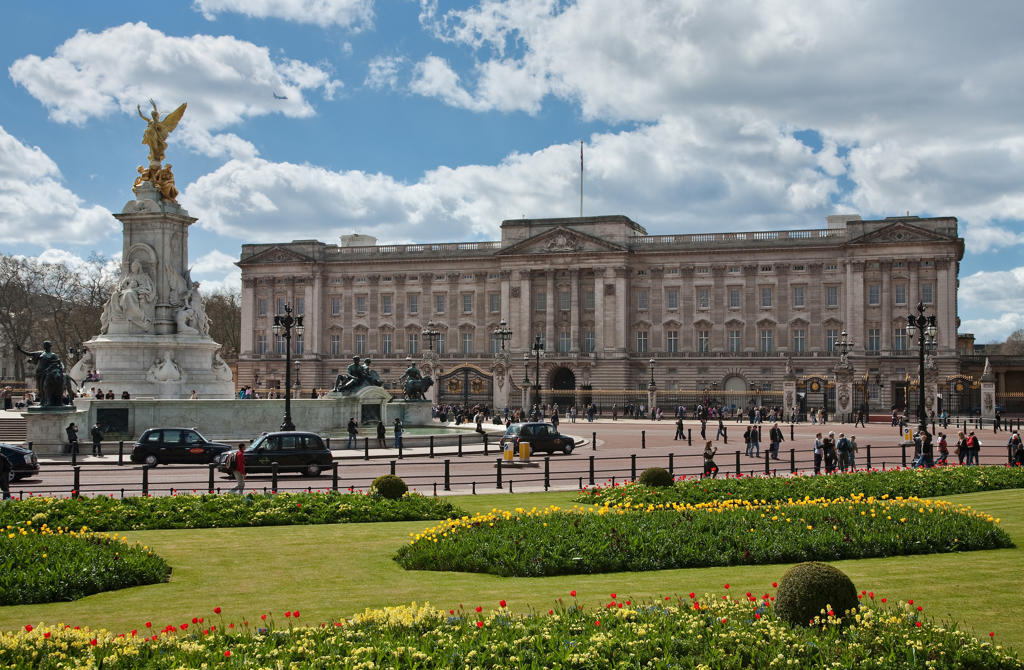About Buckingham Palace
The grand façade of Buckingham Palace, with its iconic balcony and the Union Jack flying high, stands as a symbol of British monarchy and tradition. The palace's neoclassical architecture, characterized by its symmetrical design and the use of Portland stone, exudes a sense of regal elegance. The central balcony, known for royal appearances during significant events, draws the eye, while the intricate ironwork of the gates and the meticulously maintained gardens add to the palace's majestic presence. Visitors often gather to witness the Changing of the Guard, a ceremonial display of British pageantry that takes place in the forecourt.
Originally built as Buckingham House in 1703 for the Duke of Buckingham, the building was acquired by King George III in 1761 as a private residence for Queen Charlotte. It was transformed into a palace by architects John Nash and Edward Blore in the 19th century, becoming the official London residence of the British monarch in 1837 with Queen Victoria's accession. The palace has since been the backdrop for numerous historical events, from royal weddings to state banquets, and remains a focal point of national celebrations and mourning.
Right Where It Began
The transformation of Buckingham House into Buckingham Palace marks a significant chapter in British history. Originally a private residence, its evolution into a royal palace reflects the changing nature of the British monarchy and its role in society. The palace's expansion under King George IV and Queen Victoria's decision to make it her official residence highlight its importance as a symbol of continuity and tradition. Today, the palace serves as the administrative headquarters of the monarchy, hosting state visits and official events that reinforce its status as a center of British ceremonial life.
Plan your perfect trip to London with Travo! Download now and start exploring.
Marks of Time
The architectural features of Buckingham Palace tell stories of its past. The East Front, added by Edward Blore in 1850, is the most recognizable aspect of the palace, with its balcony serving as a stage for royal appearances. The palace's interior, though not open to the public year-round, is known for its opulent rooms, including the Throne Room and the White Drawing Room, which are used for official receptions. The palace's gardens, covering 39 acres, provide a tranquil setting and are home to a variety of flora and fauna, including the famous lake and the Rose Garden.
Stories in Stone
The stonework of Buckingham Palace is rich with historical significance. The Portland stone used in its construction is a hallmark of British architecture, symbolizing strength and durability. The palace's design, with its classical columns and pilasters, reflects the influence of neoclassical architecture, popular in the 18th and 19th centuries. The Victoria Memorial, located in front of the palace, adds to the narrative, commemorating Queen Victoria's long reign and her impact on the British Empire. This monument, with its gilded statue of Victory, serves as a reminder of the monarchy's enduring legacy.
Details That Speak
Notice the intricate details of the palace's gates, crafted by the Bromsgrove Guild of Applied Arts. These gates, adorned with the royal coat of arms, symbolize the monarchy's authority and the palace's role as a seat of power. The Changing of the Guard, a tradition dating back to the 17th century, is a spectacle of precision and discipline, reflecting the ceremonial duties of the Household Division. The guards, in their distinctive red tunics and bearskin hats, march to the sound of military bands, providing a glimpse into the pageantry and discipline of the British armed forces.
Living History
Buckingham Palace remains a living symbol of the British monarchy, its walls echoing with the history of the nation. The palace is not only a residence but also a working building, where the Queen meets with heads of state and conducts official business. During the summer months, the State Rooms are open to the public, offering a rare glimpse into the opulence and grandeur of royal life. The palace's role in national events, from Trooping the Colour to the Queen's annual Christmas broadcast, underscores its significance as a focal point of British cultural and political life.

Location
Ambassador's Court, SW1A 1AA, London


